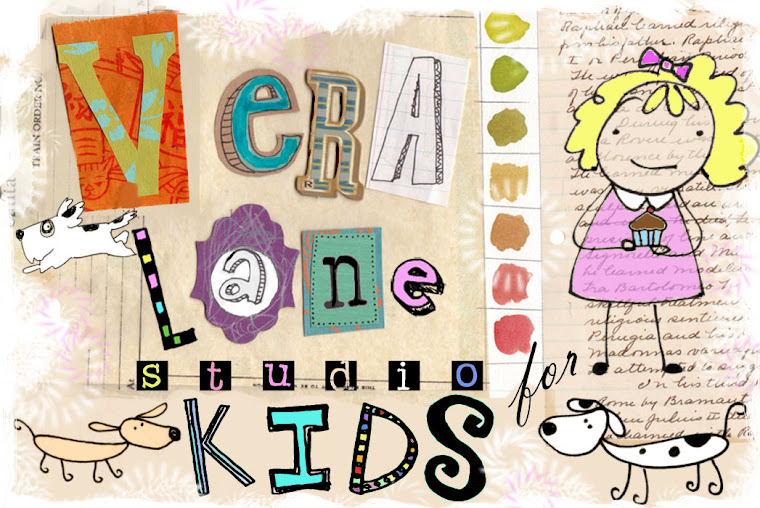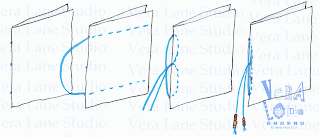Wednesday, September 25, 2013
Collage Portrait
Aimee and I have been working on mixed media this past month. I think she did an outstanding job on her collage portrait.
Wednesday, September 18, 2013
Why I like collage for children
Aimee has been working on a mixed media project here on Vera Lane. She's a self-taught talented young artist. Aimee loves using her natural ability drawing cartoon characters from YouTube videos. Her art style has taken on that of the images she’s copying. While her drawing skill is exceptional, I am trying to get their out of her comfort zone and open up possibilities.
When a child digs into a basket or box of scraps, they see possibilities. A variety of shape, color, texture, and patterns is at their fingertips. It's a treasure hunt. It's old school. It's up cycling and repurposing. It's an opportunity to never look at a piece of paper the same way. Tags, sheet music, scrap paper bits, gift wrap, letters, junk mail, tickets and other bits of ephemera --- fill a box and let your child create.
Whether working to create a collage to depict an image or scene or totally non-objective, children are choosing and judging spatial relationships. The child observes and works with balance and proportion, positive and negative space. This endeavor opens up creative thinking. What I love most about this process is the “play” of arrangement, there is no commitment until the piece is glued in place.
And then, that special piece of paper sparks imagination. When Aimme looks up and me and asks, "May I take this piece home?" I know I have created another fan of paper.
Friday, June 21, 2013
The Pamphlet Stitch for Children
Aimee, Caroline, and Kevin are putting the finishing touches on their three hole pamphlet stitch mini books. These are simple to make for a stitch bound book.
Cut card stock to create the cover.
8 1/2 x 11" card stock is halved to 8 1/2 x 5 1/2" . You will fold this in half.
Trim four sheets of text weight paper for the pages (signature) -- fold separately and tuck into the folded spine cover. Make sure all your pages and cover are in alignment -- use a paper or binder clip to hold in place.
You may need an adult to help you punch holes along the spine. If you don't have an awl, you can twist a push pin to create holes. The top and bottom holes should be about an inch from the head and tail, and the third hole is centered. Check your openings to make sure your cord can pass through -- you can do this without a needle.
The easy method I've come up with is fool proof! In less than a minute you will have a bound booklet!
Cut a piece of cord (or whatever you have to fit the holes; embroidery floss will work well and comes in a wide variety of colors) three times the height of the book.
Begin on the OUTSIDE cover -- insert the cord ends through the top and bottom holes. Have them BOTH enter the center hole.
Place one end on either side of the long stitch along the spine and double knot. This is a symmetrical stitch.
Have fun tying beads or charms on the end.
These little books can be made with scrapbook papers or upcycled papers. They are great for little journals or sketchbooks.
Have fun!
Sunday, March 24, 2013
Vincent Van Gogh for Kids
Vincent Van Gogh had his own way of seeing. While his art went unappreciated in his lifetime, the world regards him as one of the most famous artists who has ever lived. You'll know this to be true should you have the opportunity to view a Van Gogh in person.
Here are some kid-friendly interactive sites to increase your knowledge of Vincent Van Gogh.
The Metropolitan Museum of Art; How Van Gogh made his mark
Here are some kid-friendly interactive sites to increase your knowledge of Vincent Van Gogh.
The Metropolitan Museum of Art; How Van Gogh made his mark
Friday, March 15, 2013
Homemade Stamps

Simple bold shapes created from these printed images are appealing to children. Printing not only involves problem-solving skills, it is a preview to graphic and textile design. Children will become more aware of patterns in their environment.
Making these stamps for printing patterns is fast and easy. All you need are some old blocks, scissors and sheets of fun foam. You can use the foam with adhesive backs or glue on yourself.
Cut foam into size of the blocks.
Free cut your designs with straight or crazy edge scissors. If you are gluing the foam to the block,
allow drying time.
Printing: You can use stamp pads or
apply a thin layer of acrylic or tempera paints with a sponge.
- Have children explore with a simple AB pattern (two alternating images) or more completed a,
- Drop pattern (Shape, space, shape, space – a good example of a drop pattern is a polka dot pattern.
- Rotation: Have children change direction with a single image. Left , right, or more complicated, North, East, South, West. You can number or code the block to take the confusing our of turning.
Have children explore the stamp itself.
Why does only the image print and not the entire block? (the design is raised like a thumb print, the
design is in relief). Discuss the use of
negative space and positive space; how is the negative space just as important
to the design as the positive space?
Paint and decorate papers. Keep them for collages.
- Try stamping fabric
- Create wrapping paper
- Design note cards
- Create a logo and print calling cards
- Make a mini book of stamped images
- Decorate a plain box
- Use acrylic paint to make a personal t-shirt
Talk about the similarities and differences in the patterns created. Making stamps at home in the classroom is easy, fun, and inexpensive.
Happy stamping!
Subscribe to:
Posts (Atom)










